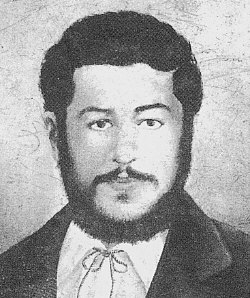Top Qs
Timeline
Chat
Perspective
Papken Siuni
Armenian revolutionary (1873–1896) From Wikipedia, the free encyclopedia
Remove ads
Bedros Parian (Armenian: Պետրոս Փարեան; 1873 – 26 August 1896), better known by his nom de guerre Papken Siuni (Բաբգէն Սիւնի), was an Armenian revolutionary and a leading figure in the late 19th-century Armenian national movement. A member of the Armenian Revolutionary Federation (ARF),[1] he co-led the 1896 Ottoman Bank takeover, a seminal event aimed at internationalizing the Armenian Question amid the Hamidian massacres. His death during the operation cemented his status as a martyr in Armenian history.
Remove ads
Early life and education
Bedros Parian was born in 1873 in the village of Pingian (modern-day Adatepe), near Akn in the Harput Vilayet of the Ottoman Empire. His family belonged to the Armenian peasantry, though they traced their lineage to the medieval Artsakh nobility.[2] The region's Armenian population faced systemic discrimination under Ottoman rule, including heavy taxation and periodic violence.[3]
In 1887, Parian moved to Constantinople to attend the Getronagan Armenian High School, a hub for Armenian intellectual and nationalist thought.[4] There, he joined clandestine student circles influenced by the Armenian Enlightenment and the writings of Mkrtich Khrimian. His teachers included prominent intellectuals like Reteos Berberian, who emphasized Armenian cultural revival.[5]
Remove ads
Revolutionary career
Early activism
Parian adopted the pseudonym "Siuni" in homage to Syunik, a historic Armenian region known for resistance against foreign rule. By 1890, he co-founded the underground group Syunik, which merged with the ARF in 1893.[6] The ARF, founded in 1890, sought to unify Armenian resistance through armed struggle and diplomatic appeals to European powers.[7]
Hamidian massacres and radicalization
The Hamidian massacres (1894–1896) devastated Armenian communities, claiming over 100,000 lives.[8] Parian's parents were killed during massacres in Harput, a trauma that radicalized him.[2] In 1895, he relocated to Constantinople, where he organized ARF cells and distributed anti-Ottoman literature. Disguised as a porter, he evaded Ottoman authorities while smuggling weapons.[9]
Remove ads
Ottoman Bank takeover
Planning and objectives
In early 1896, ARF leaders, including Christapor Mikaelian, approved Siuni's proposal to seize the Ottoman Bank, a financial hub for European investors. The operation aimed to force European intervention by threatening economic interests.[10] Siuni and Karekin Pastermadjian (Armen Garo) recruited 28 militants, including students and artisans, and stockpiled grenades and Mauser pistols.[11]
The attack
On 26 August 1896, the group stormed the bank, taking 150 hostages.[12] Siuni carried explosives under a traditional Armenian vest (arkhalig). During the initial assault, a stray bullet detonated a grenade, killing him instantly.[5][13] Despite his death, the militants held the bank for 14 hours, demanding European oversight for Armenian reforms.[14]
Aftermath
French and Russian diplomats negotiated the militants' safe passage to Marseille. While the takeover drew global headlines, European powers took no concrete action, emboldening Ottoman reprisals.[15] Over 6,000 Armenians in Constantinople were massacred in retaliation.[16][17]
Legacy
Papken Siuni became a symbol of Armenian resistance. The ARF eulogized him as a "martyr of the nation," and his portrait circulated widely in Armenian diaspora communities.[18] In 2016, a memorial plaque was installed near the Ottoman Bank building (now the Istanbul Museum of the History of Science and Technology in Islam).[19]
Historians debate the takeover's efficacy. While some argue it raised international awareness,[20] others criticize it for provoking further violence.[a][23] Nevertheless, Siuni's tactics influenced later ARF operations, including the 1904 Sasun uprising.[24]
Remove ads
See also
Notes
- Taner Akçam argues that such operations inadvertently justified Ottoman claims of Armenian "sedition," escalating state violence.[21] In his memoirs, Karekin Pastermadjian, a planner of the takeover, wrote that international indifference left no peaceful alternatives.[22][failed verification]
References
Bibliography
Wikiwand - on
Seamless Wikipedia browsing. On steroids.
Remove ads

